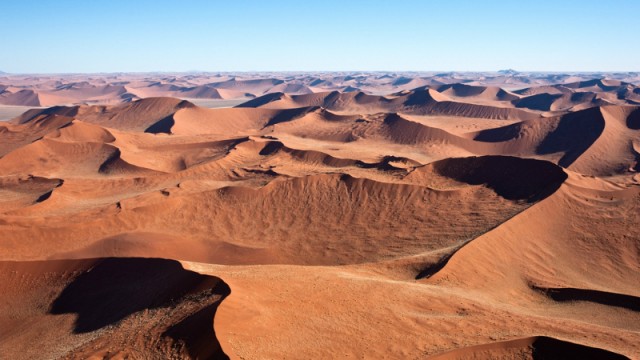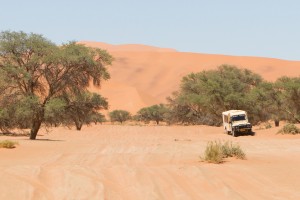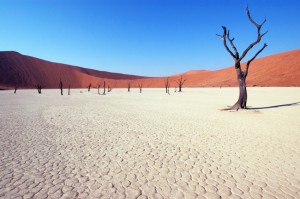I’ve driven a lot of miles over the years. Choosing a career as a travel writer at the age of 23 ensured that. I got my start updating back-to-back Lonely Planet guides that had me driving across America and much of Southern Africa, then taking road trips up the Australian coast and around chunks of Asia.
I estimate I’ve covered some 100,000 miles of pavement since beginning my travel writing journey, but I’ve never driven through more lonely country than I found in Namibia, especially the stretch from the South African border to the towering dunes at Sossusvlei. The vast sand desert, known as the Central Namib, stretches for more than 2,000km, from South Africa’s Oliphants River to the Angolan border. It is one of the most isolated, at times terrifying, and altogether magnificent places I’ve ever driven through — and that includes driving from the top to the bottom of Madagascar.
It is a long two-day drive from Cape Town to Sesreim, the gateway to the red sand dune sea that is Namib-Naukluft National Park with its most ephemeral oasis, Sossusvlei.
As I leave behind the modern beauty of Cape Town, driving north on the N7, the landscape quickly changes. Cities fall away and so do the number of cars on the road. Soon I’m driving 100 km before passing another town, and when I do find one, I’m lucky if it has a petrol station. Before I know it, mine is the only vehicle on the road; a highway that seems to stretch on forever though a landscape of scrub brush and rocky hills juxtaposed against a deep ocean blue sky, so big and low it feels like it will swallow you. If the road seemed lonely in South Africa’s Namaqualand outback, crossing the border into Namibia only intensifies the feeling. But lonely isn’t quite the right word. It’s more immense. All consuming. Barren. Grandiose. Humbling? It makes you realize how small you are here. You could die on one of the deserted highways, where cell phone service is still a thing of the future – I didn’t even know places like that existed any more – and no one would know.
The last bit of driving to Sesreim is on mean gravel roads where rocks fly every which way and I feel like I am going mad from all the emptiness and sky. But just when I think I can’t take a moment of being in such an isolated barren land for a moment longer without screaming, the dunes appear without warning. Where there was once just sun-bleached scrub is now there is a vision of blood-red sand mountains. Suddenly I am in the midst of the Namibia of picture books and movies. It is an experience that leaves me so speechless I pull the car off the edge of the gravel road, stop the engine and just stare, open-mouthed, at my hauntingly beautiful surroundings. The dunes, which reach as high as 325 m, are part of one of the oldest and driest eco-systems on earth. The landscape here is constantly changing. Colors shift with the light, and wind forever alters the dune’s shape.
The Namib-Naukluft Park is best known for Sossusvlei, a huge ephemeral pan set amid these infamous towering red dunes. And despite being Namibia’s number one attraction, Sossusvlei still manages to feel isolated. From Sesriem it’s 65 km on a paved road to Sossusvlei. On the way you pass Dune 45, the most accessible of the red dunes along the Sossusvlei road, which is marked by a sign and is a must-stop for photos. The 2×4 Car Park marks the end of the road. From here you can either leave your car and hike the last 4 km into the pan, or pay a small fee for a shuttle. I choose to do the later, as I have arrived at mid-day and the heat is dry but intense, and I know I will be walking plenty upon arrival.
Hiking through the dunes, part of the 32,000 km sand sea that covers much of western Namibia, is as somber of an experience as the drive to get there. I highly recommend hiring a local guide. Not only does this help support a poor economy, but it also means you won’t get lost in this unmarked, highly disorienting wilderness. I ask to be taken to Deadvlei. The walk, while hot, is not technical, and feels surreal. Even as I’m experiencing it, even as I’m staring at towering pillars of sand in every direction, snapping pictures of razor sharp dunes under a cloudless blue sky with sun so bright it gives the image a natural Instagram filter intensity with one camera, while shooting video with another, none of it feels real. Instead, it’s like I’m Alice tripping down the rabbit hole and ending up on another planet.
When my guide and I reach Deadvlei, the location is exactly as the name describes: an eerie stand of dead trees in an ethereal pan ringed by a mountain range of sand. We continue walking after a pause by the blackened trees, where I drain half my Camelbak in one gulp. The sand is hot on my feet and it is hard to walk in the dry, dry heat. But at the same time, it’s too disorienting to stop, so up the dunes I climb, walking the ridge in the footsteps of my guide. I feel as if I’ve reached the ends of the earth, but that’s too cliché a phrase to actually explain what I’m really feeling. It is just too big to fully absorb on first sight. I know I must return.
And so I do for sunrise the next morning. Witnessing the sunrise over the dunes at Sossusvlei is a bucket list-worthy experience that lives up to its expectations. The way the colors shift as the sun rises in the sky is ethereal. I try to let my mind expand and savor the moment, to memorize this otherworldly landscape now glowing in the soft light of early morning, to fully feel the solitude, serenity, and absolutely stillness of the place. It is truly an experience like no other.
Practical considerations: Seeing the dunes is an exclusive experience, one that can only be had by flying in via helicopter or taking the time to drive to the middle of nowhere. And unless you have some cash to burn, sleep in a tent the night before seeing the sunrise.



